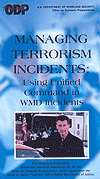|
Managing Terrorism
Incidents - Series (Video)
The contents of this series were developed in coordination with the
Federal Bureau of Investigation, Federal Emergency Management Agency,
including the U.S. Fire Administration's National Fire Academy and
the Emergency Management Institute, U.S. Department of Energy, U.S.
Environmental Protection Agency, and the U.S. Public Health Service
Office of Emergency Preparedness.
|
|

|
Managing Terrorism Incidents:
Using the Incident Command System for WMD Incidents (Video)
This program is part one of the series, "Managing Terrorism Incidents."
It is designed to enhance the knowledge and understanding of the Incident
Command System (ICS) for personnel who may become involved in the response
to an act of terrorism. It describes ICS and explains its application in
a WMD event and how it evolves during the initial response. It discusses
the basic command structure, roles and responsibilities of the Incident
Commander's staff and the functional Sections that are established
as part of ICS.
|
|

|
Managing Terrorism Incidents:
Using Unified Command on WMD Incidents (Video)
This program is part two of the series, "Managing Terrorism Incidents."
It is designed for personnel who may become involved in a multi-agency
or multi-jurisdictional response to an act of terrorism. This program
will build upon the concept of the Incident Command System (ICS) and
show the transition from a single Incident Commander to a Unified Command,
how the incident is managed under Unified Command, and the roles and
responsibilities of agencies that participate. It will examine the
operating facilities that support WMD incident operations and will
explain how they work together. In addition, the concepts of crisis
and consequence management will be covered.
|
|

|
Surviving the Secondary
Device - the Rules Have Changed (Video)
Produced in partnership with the Georgia Emergency
Management Agency, this video is designed to assist public safety
officials in making informed decisions concerning the real potential
of secondary explosive devices. These devices, which detonate after
the initial explosion, target blast survivors, other individuals
who converge on the scene, and, more often, responding public safety
personnel. The possibility of secondary devices require that public
safety officials not only look at how to protect the lives our citizens,
but how to protect the responders. This video discusses policies
and procedures for effectively responding to and managing a bomb
incident, and for better ensuring the safety of the public and the
emergency responder.
|
|

|
Surviving Weapons of Mass
Destruction (Video)
The threat of terrorist incidents involving chemical
or biological agents is very real. This training video is designed
to enhance the survival and safety of emergency responders during
such incidents. Although protecting the public is the principal
mission of all public safety agencies, it is also important that
emergency responders do not forget their own safety. This video,
produced in partnership with the Georgia Emergency Management Agency,
approaches safety from the individual responder and an agency perspective.
|
|

|
Weapons of Mass Destruction
- the First Responder (Video)
Being prepared for incidents involving weapons of
mass destruction means knowing what to look for and how to react.
Preparation means that all emergency response agencies, including
law enforcement, fire, emergency medical services and others, at
all levels of government, work together in responding to such events.
This video, produced in partnership with the City of Seattle Fire
Department, was prepared to familiarize emergency responders with
steps they can take to mitigate the effects of such incidents and
to better ensure their own and the publicís safety.
|
|
|




